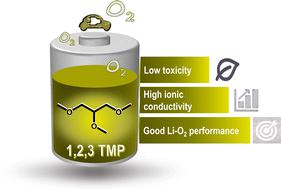当前位置:
X-MOL 学术
›
Green Chem.
›
论文详情
Our official English website, www.x-mol.net, welcomes your
feedback! (Note: you will need to create a separate account there.)
1,2,3-Trimethoxypropane: a bio-sourced glyme as electrolyte for lithium–O2 batteries
Green Chemistry ( IF 9.3 ) Pub Date : 2022-07-18 , DOI: 10.1039/d2gc01567f Marta Alvarez-Tirado 1, 2 , Laurent Castro 2 , Shuai Qian 3 , Jason E. Bara 3 , Marco Di Gennaro 4 , Konstantinos Gkagkas 2 , Aurélie Guéguen 2 , David Mecerreyes 1, 5
Green Chemistry ( IF 9.3 ) Pub Date : 2022-07-18 , DOI: 10.1039/d2gc01567f Marta Alvarez-Tirado 1, 2 , Laurent Castro 2 , Shuai Qian 3 , Jason E. Bara 3 , Marco Di Gennaro 4 , Konstantinos Gkagkas 2 , Aurélie Guéguen 2 , David Mecerreyes 1, 5
Affiliation

|
Li–O2 batteries are actively being investigated due to their high theoretical energy density (∼11 000 Wh kg−1), which would compete with gasoline energy per Kg in electric vehicles. Linear glymes are the most appealing electrolytes for Li–O2 batteries due to their large electrochemical window, stability against radicals and solubility of Li+ metal ions. However, all these superior properties are tarnished by their high toxicity. Herein, a greener glyme derived from bio-sourced glycerol (1,2,3-trimethoxypropane (TMP)), is proposed for the first time as a solvent in an electrolyte for Li–O2 batteries. TMP performance has been compared to its toxic linear isomer, diglyme, and most popular tetraglyme as a liquid electrolyte and gel polymer electrolyte (GPE) membranes. GPEs were based on a mix of mono-, di- and tri- functional acrylates, cured simultaneously within a liquid electrolyte mix (1 M LiTFSI in the plasticizers) by UV-photopolymerisation. GPE-TMP based membranes showed a high ionic conductivity (2.33 × 10−3 S cm−1 at 25 °C), directly comparable to the other glymes. Moreover, this remarkable conductivity was very close to the liquid TMP-based electrolyte (3.59 × 10−3 S cm−1 at 25 °C). When used as electrolytes in lithium symmetrical cells, the GPE-TMP electrolyte enhanced the polarisation when compared to the liquid TMP-based cells, especially at higher rates (<0.6 V observed at ±1 mA cm−2). Performance in Li–O2 cells showed that GPE-TMP electrolytes achieved a discharge capacity as high as 2.75 mA h cm−2 (3819 mA h g−1), ahead of GPE-diglyme or GPE-tetraglyme electrolytes (2.34 and 2.09 mA h cm−2, respectively). When cycled, cells using TMP-based electrolyte had a similar capacity retention than the ones with tetraglyme, confirming the potential use of TMP as solvent/plasticizer in electrolytes for Li–O2 cells.
中文翻译:

1,2,3-三甲氧基丙烷:一种生物来源的甘醇二甲醚作为锂-O2电池的电解质
Li-O 2电池因其高理论能量密度(~11 000 Wh kg -1)而受到积极研究,这将与电动汽车中的每公斤汽油能量竞争。线性甘醇二甲醚是 Li-O 2电池最吸引人的电解质,因为它们具有较大的电化学窗口、对自由基的稳定性和 Li +金属离子的溶解性。然而,所有这些优越的特性都被它们的高毒性所玷污。在此,首次提出了一种源自生物源甘油(1,2,3-三甲氧基丙烷(TMP))的更环保的甘醇二甲醚作为 Li-O 2电解质中的溶剂电池。TMP 的性能与其有毒的线性异构体、二甘醇二甲醚和最流行的四甘醇二甲醚作为液体电解质和凝胶聚合物电解质 (GPE) 膜进行了比较。GPE 基于单官能、双官能和三官能丙烯酸酯的混合物,通过紫外光聚合在液体电解质混合物(增塑剂中含有 1 M LiTFSI)中同时固化。基于 GPE-TMP 的膜显示出高离子电导率(25 °C 时为 2.33 × 10 -3 S cm -1),与其他甘醇二甲醚直接可比。此外,这种显着的电导率非常接近液态 TMP 基电解质(3.59 × 10 -3 S cm -1在 25 °C)。当用作锂对称电池中的电解质时,与基于 TMP 的液体电池相比,GPE-TMP 电解质增强了极化,特别是在更高的速率下(在 ±1 mA cm -2观察到 <0.6 V )。在 Li-O 2电池中的性能表明,GPE-TMP 电解质的放电容量高达 2.75 mAh cm -2 (3819 mA hg -1 ),领先于 GPE-二甘醇二甲醚或 GPE-四甘醇二甲醚电解质 (2.34 和 2.09 mA h) cm -2,分别)。循环时,使用基于 TMP 的电解质的电池与使用四甘醇二甲醚的电池具有相似的容量保持率,这证实了 TMP 在 Li-O 2电池电解质中作为溶剂/增塑剂的潜在用途。
更新日期:2022-07-21
中文翻译:

1,2,3-三甲氧基丙烷:一种生物来源的甘醇二甲醚作为锂-O2电池的电解质
Li-O 2电池因其高理论能量密度(~11 000 Wh kg -1)而受到积极研究,这将与电动汽车中的每公斤汽油能量竞争。线性甘醇二甲醚是 Li-O 2电池最吸引人的电解质,因为它们具有较大的电化学窗口、对自由基的稳定性和 Li +金属离子的溶解性。然而,所有这些优越的特性都被它们的高毒性所玷污。在此,首次提出了一种源自生物源甘油(1,2,3-三甲氧基丙烷(TMP))的更环保的甘醇二甲醚作为 Li-O 2电解质中的溶剂电池。TMP 的性能与其有毒的线性异构体、二甘醇二甲醚和最流行的四甘醇二甲醚作为液体电解质和凝胶聚合物电解质 (GPE) 膜进行了比较。GPE 基于单官能、双官能和三官能丙烯酸酯的混合物,通过紫外光聚合在液体电解质混合物(增塑剂中含有 1 M LiTFSI)中同时固化。基于 GPE-TMP 的膜显示出高离子电导率(25 °C 时为 2.33 × 10 -3 S cm -1),与其他甘醇二甲醚直接可比。此外,这种显着的电导率非常接近液态 TMP 基电解质(3.59 × 10 -3 S cm -1在 25 °C)。当用作锂对称电池中的电解质时,与基于 TMP 的液体电池相比,GPE-TMP 电解质增强了极化,特别是在更高的速率下(在 ±1 mA cm -2观察到 <0.6 V )。在 Li-O 2电池中的性能表明,GPE-TMP 电解质的放电容量高达 2.75 mAh cm -2 (3819 mA hg -1 ),领先于 GPE-二甘醇二甲醚或 GPE-四甘醇二甲醚电解质 (2.34 和 2.09 mA h) cm -2,分别)。循环时,使用基于 TMP 的电解质的电池与使用四甘醇二甲醚的电池具有相似的容量保持率,这证实了 TMP 在 Li-O 2电池电解质中作为溶剂/增塑剂的潜在用途。






























 京公网安备 11010802027423号
京公网安备 11010802027423号